Abstract
Pollen from 152 collections representing 16Pyrola species was examined with LM, SEM and TEM. The genusPyrola is stenopalynous in having tetrads and 3-colporoidate grains. However, a continuous and serial variation in the exine sculpture and the tetrad diameter (D) was revealed within the genus. Křísa's system ofPyrola (1971) was re-examined in the light of these palynological characters which may have a taxonomic significance, as well as the external morphology.
P. minor (only member of the subgenusAmelia), which is characterized by having small (D=30–35 μm) pollen tetrads with verrucate sculpture must best be placed near sectionPyrola of the subgenusPyrola. P. faurieana must be segregated from sectionChlorantha and together withP. media placed intermediate between the subgenusAmelia and sectionPyrola of the subgenusPyrola based on their larger (D=ca. 40 μm) pollen tetrads with verrucate sculpture. Two series of sectionChlorantha excludingP. faurieana are differentiated in the exine sculpture. Therefore, they are regarded as the distinct taxonomic groups. SectionScotophylla is characterized by having psilate sculptured pollen tetrads, which indicates that its sectional rank is sufficiently asserted. The evolutionary trend in the exine sculpture from verrucate through rugulate to psilate is suggested withinPyrola.
Similar content being viewed by others
References
Alefeld, F. 1856. Ueber die Familie der Pyrolaceen, insbesondere die Unterfamilie der Pyroleen (gen.Pyrola L.). Linnaea28: 1–88.
Andres, H. 1914. Piroleen-Studien. Beiträge zur Kenntnis der Morphologie, Phytogeographie und allgemeinen Systematik der Pirolaceae. Verh. Bot. Ver. Prov. Brandenburg56: 1–76.
Böcher, T.W. 1961. Studies in Pyrolaceae-two interesting wintergreens from West Greenland. Bot. Tidskr.57: 28–37.
Camp, W.H. 1940. Aphyllous forms inPyrola. Bull. Torrey Bot. Club67: 453–465.
Copeland, H.F. 1947. Observations on the structure and classification of the Pyroleae. Madroño9: 33–64.
Erdtman, G. 1952. Pollen Morphology and Plant Taxonomy. Angiosperms. Almqvist & Wiksell, Stockholm.
— 1960. The acetolysis method. A revised description. Sven. Bot. Tidskr.54: 561–564.
— 1969. Handbook of Palynology. Morphology-Taxonomy-Ecology. Munksgaard, Copenhangen.
Haber, E. 1984. A comparative study ofPyrola minor×Pyrola asarifolia (Ericaceae) and its parental species in North America. Can. J. Bot.62: 1054–1061.
— 1985. The hybrid identity and taxonomic status ofPyrola sikkimensis (Ericaceae) from eastern Himalaya. Can. J. Bot.63: 133–137.
— andJ.E. Cruise. 1974. Generic limits in the Pyroloideae (Ericaceae) Can. J. Bot.52: 877–883.
Hagerup, O. 1941. Zytoökologische Bicornes-Studien. Planta32: 6–14.
House, H.D. 1921. Nomenclatorial notes on certain American plants. I. Am. Midl. Nat.7: 126–135.
Huang, T.C. 1972. Pollen Flora of Taiwan. Nat. Taiwan Univ., Taipei.
Ikuse, M. 1956. Pollen Grains of Japan. Hirokawa Pub. Co., Tokyo (in Japanese).
Knaben, G. 1944. Studier over norske.Pyrola-arter. Arbok Univ. Bergen Mat. Naturvitensk. Ser.1943 (6): 1–18.
— andT. Engelskjøn. 1968. Studies in Pyrolaceae, especially in thePyrola rotundifolia complex. Arbok Univ. Bergen Mat. Naturvitensk Ser.1967 (4): 1–71.
Křísa, B. 1971. Beitrag zur Taxonomie und Chrologie der GattungPyrola L. Bot. Jahrb. Stuttgart90: 476–508.
Nakamura, J. 1980. Diagnostic characters of pollen grains of Japan. I. Spec. Publ. Osaka Mus. Nat. Hist.13: 1–91 (in Japanese).
Nowicke, J.W. 1966. Pollen morphology and classification of the Pyrolaceae and Monotropaceae. Ann. Missouri Bot. Gard.53: 213–219.
Oldfield, F. 1959. The pollen morphology of some of the West European Ericales. Pollen et Spores1: 19–48.
Pyykkö, M. 1968. Embryological and anatomical studies on Finnish species of the Pyrolaceae. Ann. Bot. Fenn.5: 153–165.
Rydberg, P.A. 1914. Pyrolaceae. North Am. Flora29: 21–32.
Spurr, A.R. 1969. A low-viscosity epoxy resin embedding medium for electron microscopy. J. Ultrastruct. Res.26: 31–43.
Takahashi, H. andK. Sohma. 1980. Pollen development inPyrola japonica Klenze. Sci. Rep. Tohoku Univ. Ser. IV (Biol.)38: 57–71.
Ueno, J. 1962. Palynological notes on Ericaceae and Pyrolaceae from Japan and its neighbours. Acta Phytotax. Geobot.20: 101–111.
Author information
Authors and Affiliations
Rights and permissions
About this article
Cite this article
Takahashi, H. Pollen morphology ofPyrola and its taxonomic significance. Bot Mag Tokyo 99, 137–154 (1986). https://doi.org/10.1007/BF02488816
Received:
Issue Date:
DOI: https://doi.org/10.1007/BF02488816




